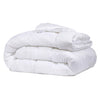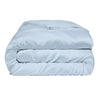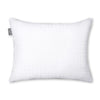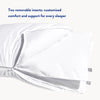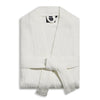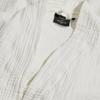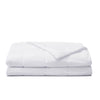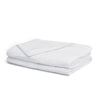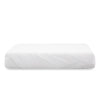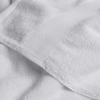The Daily Miracle
What Goes Inside A Duvet Cover?
Published
May 22, 2025
Author
John Tsenekos

If you've ever wondered why your bedding never feels quite as cozy as you'd hoped, you're not alone. Figuring out what goes inside a duvet cover can be surprisingly confusing. With so many types of duvet inserts and endless options for bedding layers, knowing how to use a duvet cover properly makes all the difference in achieving lasting sleep comfort.
Whether you're deciding between down and synthetic inserts or just want tips to keep your bed fresh and inviting, this article will guide you through the essentials. We've jotted down some practical advice and care instructions to help simplify your bedding choices so you can create the perfect sleep setup.
What is A Duvet Cover And Why Use One?
A duvet cover is essentially a protective layer for your comforter, often called a duvet insert. Think of it like a pillowcase for your bedding! It slips over the duvet and fastens closed with buttons, snaps, or a zipper, serving both practical and decorative purposes. Using a duvet cover makes bed-making easier; instead of handling a bulky comforter, you simply wash the cover. This protects your duvet insert from dirt, dust, and wear, extending its lifespan.
Additionally, duvet covers let you change the look of your bedroom easily with various patterns, colors, and materials, without replacing the entire comforter. Selecting the right duvet cover contributes significantly to both comfort and style in your bedroom.
So, What Goes Inside A Duvet Cover?
Confusion about what goes inside a duvet cover arises from differing terminology and regional bedding practices. In many areas, the terms “duvet” and “comforter” are used interchangeably, creating uncertainty about whether you need both.
A comforter is a single, quilted bedding item, while a duvet is a plain insert designed to be covered. The fact that a duvet requires a separate cover adds a step unfamiliar to many transitioning from traditional comforters. Furthermore, the duvet insert must precisely match the duvet cover size to avoid bunching or sagging, adding another layer of complexity.
How To Put A Duvet Insert Inside A Duvet Cover Easily
Here's a step-by-step guide to help you put a duvet insert inside a duvet cover to ensure there's no bunching or sagging when it's used.
Step 1: Turn the Duvet Cover Inside Out
Start by turning your duvet cover completely inside out. Lay it flat on your bed with the opening at the foot. This creates a pocket that makes inserting the duvet much easier. Make sure the cover is fully spread out and smooth to avoid wrinkles and bunching later. It’s also helpful to have ample space, such as a large bed, to move comfortably while you work.
Preparing the cover this way sets a smooth foundation for the insertion process and helps you control the duvet’s placement.
Step 2: Lay the Duvet Insert on Top
Next, lay your duvet insert flat on top of the inside-out duvet cover. Align the corners and edges as closely as possible to ensure even distribution once fully inside. Take a moment to confirm the sizes match precisely; a mismatch will complicate the process. If the duvet is bulky, gently smooth it out to reduce air pockets. Correct initial alignment is crucial to avoid frustrating adjustments later.
Step 3: Tie or Clip the Corners
Most duvet covers and inserts include loops or ties at each corner. Securely tie these together. Some sets use clips instead of ties; these function similarly by holding the insert in place. This step prevents the duvet insert from shifting while you close the cover, providing essential anchor points. Without securing the corners, the insert can easily move out of place, requiring you to start over.
Step 4: Button or Zip the Cover Closed
Starting at the head of the bed, reach inside the duvet cover and grab the corresponding corner of the insert. Gently shake the cover downward, working the insert into place. Repeat corner by corner until the entire insert is enclosed. Finally, button or zip the opening closed, ensuring a snug fit. Avoid pulling harshly on zippers or buttons to prevent damage. A gentle, methodical approach yields the best results.
Step 5: Fluff and Adjust
After closing the duvet cover, give the duvet a good fluff to distribute the insert evenly. Smooth out wrinkles and bunches, paying close attention to corners and edges for a consistent assembly. If you notice any clumped areas, gently shake and redistribute the fill. This final step ensures optimal comfort and a clean, inviting appearance. A well-fluffed duvet creates a cozy, welcoming sleep environment.
How Long Does It Take To Learn To Properly Insert A Duvet?
Learning to insert a duvet properly can take anywhere from five to ten minutes of trial for beginners to just two or three minutes with practice. The initial challenge often comes from mastering techniques like the “burrito method” or corner-tying. Many find their second or third attempt much easier as they become more comfortable maneuvering the bulky insert inside the cover. For more information, check out this video.
What Materials Are Commonly Used For Duvet Inserts?
Duvet inserts come in a variety of materials, each offering distinct benefits.
-
Down, sourced from duck or goose feathers, is prized for its superb warmth and lightweight feel, providing luxurious coziness.
-
Synthetic options like polyester or microfiber are excellent for allergy sufferers and those seeking easy care. They are usually hypoallergenic.
-
Silk inserts are valued for breathability and temperature regulation, keeping you comfortable year-round.
-
Wool is another natural choice, known for being anti-microbial, moisture-wicking, and adaptable to changing temperatures.
Ultimately, the best material depends on your personal preferences, climate, and budget considerations.
Why Does Your Duvet Insert Bunch Up Inside The Cover?
Bunching inside the cover is often due to improper insertion or size mismatch between the duvet and cover. If the insert isn’t fully shaken out and evenly spread during insertion, air pockets and uneven fill can cause clumping.
Additionally, if the duvet cover is significantly larger than the insert, the fill can shift freely, creating an uneven surface. Lack of secure corner ties or clips also allows the insert to move around. Regularly fluffing your duvet and ensuring a correct size match will help prevent bunching and maintain a consistently comfortable sleeping surface.
Can You Use Different Types Of Inserts With The Same Duvet Cover?
Yes, you can typically use different duvet inserts with the same cover as long as the sizes match. Many people switch between a down duvet for winter warmth and a lighter synthetic insert for summer. The duvet cover acts as a versatile outer layer, adapting your bedding to seasonal needs.
However, consider the weight and loft of inserts; a very heavy insert might strain buttons or zippers of a lightweight cover. Using various inserts lets you customize your sleep environment for maximum comfort throughout the year, extending the versatility of your duvet cover.
What Are The Alternatives To Using A Traditional Duvet And Cover?
Alternatives to a traditional duvet and cover include comforters, quilts, and weighted blankets. Comforters are usually cotton-made single quilted items that don’t require a cover, making them simpler to manage. Quilts offer a lightweight and decorative option often featuring detailed stitching and patterns. Weighted blankets provide a comforting, gentle pressure that promotes relaxation and improved sleep quality. Each alternative offers different warmth levels, weight, and style. Choosing the right one depends on your personal preferences for comfort, aesthetics, and care ease.
What Results Can You Expect From Using A Duvet Cover System?
A duvet cover system delivers a more convenient, hygienic, and stylish bedding experience. You’ll find bed-making easier since only the cover needs washing instead of the bulky comforter. This system also prolongs your duvet insert's life by protecting it from dirt, stains, and wear. Additionally, duvet covers allow effortless changes to your bedroom's look with different designs and colors. Overall, the system offers a customizable and comfortable sleep environment tailored to your tastes. You benefit from practicality, style, and long-term savings by maintaining a well-cared-for duvet cover system.
Common Mistakes To Avoid When Using A Duvet Cover
-
Choosing the Wrong Size: A duvet cover that’s too large or too small causes bunching and discomfort. Make sure your cover’s dimensions perfectly match your duvet insert.
-
Ignoring Corner Ties/Clips: These secure the insert and prevent shifting. Always tie or clip corner loops to keep the fill evenly distributed.
-
Not Washing the Cover Regularly: Frequent washing maintains hygiene, especially for cotton or linen covers. Aim to clean your duvet cover at least every two weeks, depending on use.
-
Using Harsh Detergents: Strong chemicals can damage fabric and reduce softness. Use gentle detergents designed for delicate materials.
-
Forgetting to Fluff: Regular fluffing after inserting the duvet keeps the fill lofted and comfortable.
Final Thoughts
In conclusion, what goes inside a duvet cover is typically a duvet insert or comforter designed to provide warmth, comfort, and insulation while the cover protects it and adds style to your bedding. Choosing the right insert, whether down or down-alternative, depends on your personal preferences, climate, and any allergies. With the right combination, your bed becomes not just a place to rest, but a retreat tailored to your comfort.
Looking to enhance your bedding with both style and function? Explore the stunning collection at Miracle Made, including our one-of-a-kind cooling comforter that keeps you refreshed all night, elegant duvet covers that complement any décor, and luxurious down-alternative inserts offering supreme comfort.
Sources:





